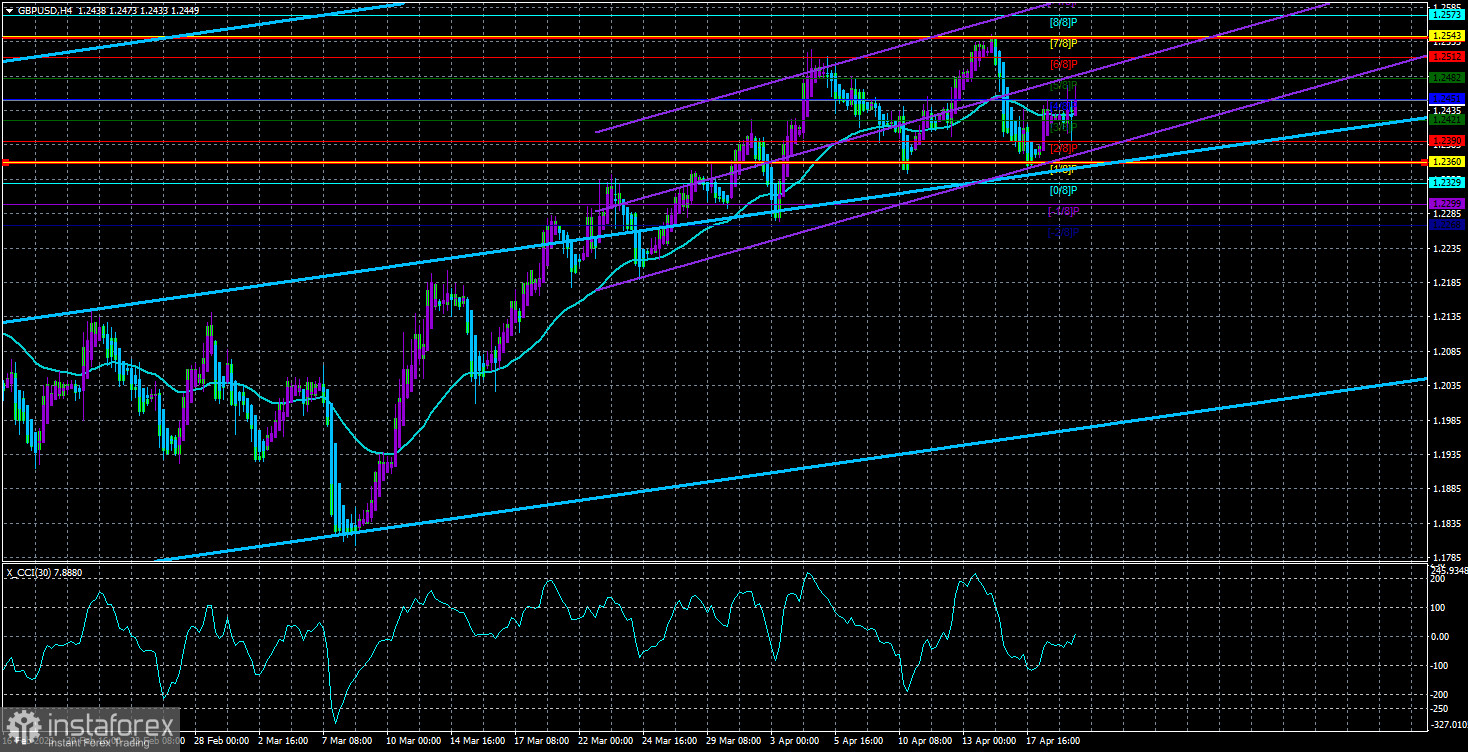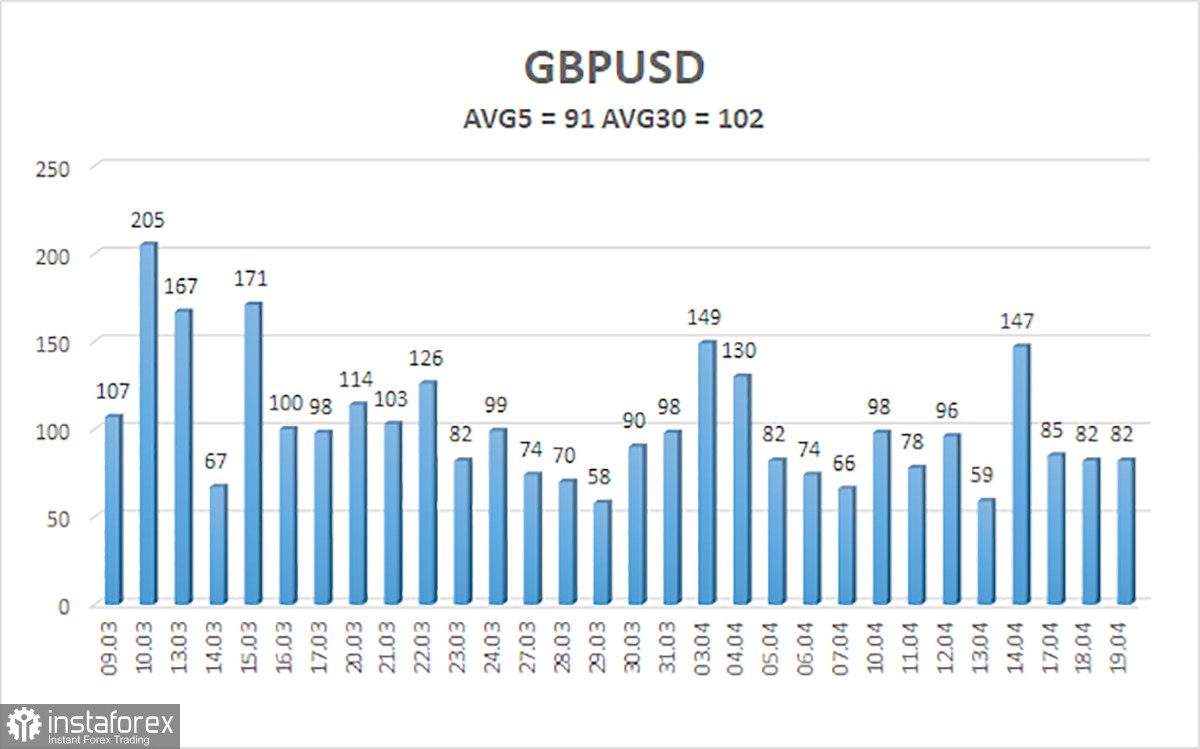
The GBP/USD currency pair showed the same "mind-blowing" movements on Wednesday as the EUR/USD pair. However, while the euro had no reason to move volatilely and trend on Wednesday (there were no important reports or events), the pound had very good reasons. However, we will talk about inflation in the UK a little later, which once again disappointed primarily the Bank of England. It is worth noting that the market is trading the pair illogically and unjustifiably for now. Of course, everyone has become accustomed to this over the past month. The movement was inertial, and the pound could not consolidate below the moving average. 750 points were covered, but it still needs to be determined why such growth occurred. The pound is overbought but desperately does not want to decline. The situation remains ambiguous despite the presence of a strong trend.
Recall that on Tuesday, a package of statistics was already released in the UK, which could bring the pound "down from heaven to earth." The unemployment rate increased, and the number of claims for unemployment benefits was much higher than the forecasts, which generally predicted their reduction. Nevertheless, the pound managed to appreciate during the day. Although these were not the most important reports, the market again showed that it could interpret any news or event. The pound appreciated weak statistics – the statistics were not the most important. Or the market experienced an increase in risk sentiment. The pound rose on the strength of strong statistics – it is logical, as the statistics support it. This is how the market has traded the pair for over a month. The price fixing below the moving average, which happened the day before, was already neutralized yesterday. So, for now, we see the same thing as before: overcoming the moving average did not lead to a serious decline in the pair.
British statistics disappointed once again.
The British inflation report is the pound's most important event of the week. Unemployment data is, of course, also important, but less so. On Tuesday, British statistics turned out to be weak; on Wednesday, they failed. The market expected inflation to fall by about 0.6% y/y in March to 9.8%, but it slowed down by only 0.3% to 10.1% y/y. Core inflation in the same month remained unchanged at 6.2%, although a decrease to 6.0% was predicted. Thus, both key reports failed. The pound reacted to them in style. No decline commensurate with the nature of the macroeconomic background followed. However, even technical analysis (fixing below the moving average) favors further declines. But the market managed to interpret the received data again in favor of the pound.
We would have called such a market reaction logical a few months ago. The fact is that earlier, while the Bank of England rate was not yet at its highest level since 2008, there was a clear correlation between inflation and the size of the rate. The market logic was as simple as a dime. If inflation grows, the Bank of England will raise rates longer and stronger to cope with the sharp price rise. Now that the BOE rate has risen to 4.25%, each new inflation failure does not mean the rate will continue to rise. And the rate hike is the main driver for the British pound (and any other currency). Thus, inflation may show growth in April, and this does not mean that the Bank of England will tighten monetary policy more strongly or for longer than planned. Therefore, the pound had no reason to grow. Still, there were reasons for it to fall, as high inflation without a key rate hike is a rather negative phenomenon for any economy and, consequently, for the national currency. In general, we risk seeing a new round of groundless growth in the British currency.

The average GBP/USD pair volatility for the last five trading days is 91 points. For the pound/dollar pair, this value is "medium." On Thursday, April 20, we expect movement within the channel, limited by levels 1.2360 and 1.2540. The reversal of the Heiken Ashi indicator back down will signal a possible resumption of the downward movement.
Nearest support levels:
S1 - 1.2421
S2 - 1.2390
S3 - 1.2360
Nearest resistance levels:
R1 - 1.2421
R2 - 1.2451
R3 - 1.2482
Trading recommendations:
The GBP/USD pair trades around the moving average line on the 4-hour timeframe. At this time, you can trade only by reversals of the Heiken Ashi indicator or on smaller timeframes, as there is no clear trend - the price is too close to the moving average and ignores it.
Explanations for the illustrations:
Linear regression channels - help to determine the current trend. If both are directed in one direction, the trend is strong now.
Moving average line (settings 20.0, smoothed) - determines the short-term tendency and direction in which trading should be conducted now.
Murray levels - target levels for movements and corrections.
Volatility levels (red lines) - the probable price channel in which the pair will spend the next day, based on current volatility indicators.
CCI indicator - its entry into the oversold area (below -250) or overbought area (above +250) means that a trend reversal is approaching in the opposite direction.





















